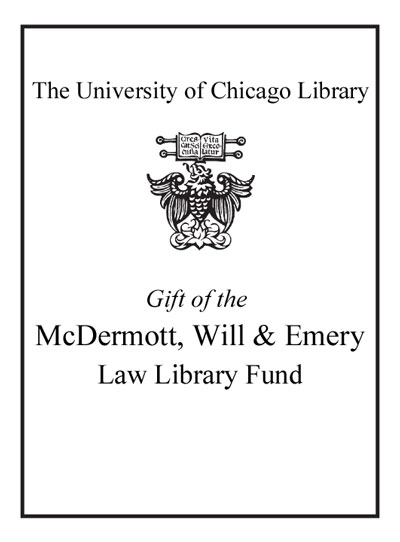Developmental and autonomy rights of children /
Saved in:
| Edition: | 2nd rev. ed. |
|---|---|
| Imprint: | Antwerp : Intersentia, 2007. |
| Description: | xxiii, 211 p. ; 24 cm. |
| Language: | English |
| Subject: | |
| Format: | Print Book |
| URL for this record: | http://pi.lib.uchicago.edu/1001/cat/bib/6648416 |
Table of Contents:
- Foreword
- Notes on Contributors
- List of Abbreviations
- Preface
- Abstracts of Chapters
- Chapter 1. Children's Rights Are Human Rights; Current Issues and Developments
- 1. Introduction
- 2. From Dependence to Emancipation
- 3. Identity, Nationality, Name and Family Relations
- 4. Children Living in Particularly Difficult Conditions
- 5. An International Right of Petition for Children?
- Chapter 2. Children's Rights and Universality
- 1. Inclusive Universality
- 1.1. From a Descriptive to a Normative Concept of Universality
- 1.2. Correcting Distortions
- 1.3. Flexibility and Transformation
- 2. International Children's Rights: Accommodating Children's Particularities to Promote the Universality of Human Rights
- 2.1. Changing the Image of Children
- 2.2. Four Types of Interests
- 2.3. The United Nations Convention on the Rights of the Child
- 2.3.1. Protectionism Prevails
- 2.3.2. Development rights
- 2.3.3. Autonomy rights
- 2.3.4. Trias Pedagogica
- 2.4. From Flexibility to Transformation?
- 3. The Universal Child? Accommodating Diversity Within International Children's Rights
- 3.1. Cultural Diversity
- 3.1.1. Expressions of cultural pluralism in the text of the CRC
- 3.1.2. Elastic language: the best interests of the child
- 3.2. Other Types of Diversity
- 3.2.1. Economic circumstances
- 3.2.2. Gender
- 4. Conclusion
- Chapter 3. The Developmental Damage to Children as a Result of the Violation of their Rights
- 1. Introduction
- 2. Pervasive Traumatic Experiences
- 3. Developmental Damage Caused by Sexual Abuse
- 4. A Case of Systematic and Accumulative Violation of Rights
- 5. Mental Sexual Abuse in the Classroom: Sexual Brainwashing
- 6. The Anxiety Model: Externalising and Internalising Behavioural Problems
- 7. Trauma and Guilt
- 8. The Perspective of the Victim
- 9. The Voice of the Child in the System of Care
- 10. Conclusion
- References
- Chapter 4. The Children's Law of Nations: The International Rights of the Child in the Trias Pedagogica
- 1. Introduction
- 2. The Children's Law of Nations: A Child-Caregiver-Community Approach to Children's Rights
- 2.1. Concepts and Terms
- 2.2. The Children's Law of Nations Binds All States, Both Rich and Poor
- 2.3. Object and Purpose of the Children's Law of Nations
- 2.4. The Emancipation of the (Young) Child: Empowering Caregivers and Building Communities
- 2.5. State Obligations: A Universal Constitutional Perspective
- 3. The International Rights of the Child in the Trias Pedagogica: An Interpretative Framework
- 3.1. The Convention on the Rights of the Child as Temple of the Trias Pedagogica: its Foundation, Pillars and Roof
- 3.1.1. Foundation
- 3.1.2. Pillars: the three P's
- 3.1.3. Roof: the fundamental principle of 'the right of the child to become an optimal person'
- 3.1.4. Firm ground
- 3.2. Trias Versus Transism
- 3.2.1. Trias pedagogica
- 3.2.2. Transism
- 3.3. The Constitutionalisation of the Trias Pedagogica: A Proposed Provision
- 3.4. Plea for Provision (Provision-Prevention) and Participation as a New Legal Paradigm
- 3.4.1. Informing the public, informing parents, informing the child
- 3.4.2. What should we do?
- 3.4.3. From passing on trauma to passing on knowledge
- 4. Ten Programmatic Rights
- 5. Conclusion
- References
- Chapter 5. Children's Rights and the Prevention of Child Abuse and Neglect: The Quest for a Trias Pedagogica of Children, Parents and Society
- 1. Introduction
- 2. International Law and the Emancipation of the Child
- 3. Human Dignity: Respect and Self-Respect
- 4. Multiculturalism or Social Exclusion?
- 5. Parental Autonomy or Transism?
- 6. Women's Rights in the Best Interests of the Child
- 7. Developmental Damage: One out of Three Children
- 8. Preparation for Parenthood as a Human Right
- 9. Trias Pedagogica: Constitutionalization and Operationalization
- 10. The CRC: Building Blocks for a Constitutional Trias Pedagogica
- 11. Continuum of Care: Combined Universal, Selective and Indicated Prevention
- 12. Conclusion
- Chapter 6. The Convention on the Rights of the Child: Orientation and Conceptualization of Children's Rights
- 1. Introduction
- 2. Orientation
- 3. Conceptualization
- 4. Conclusion
- References
- Appendices
- Chapter 7. Children's Rights at a Dignitarian Horizon of Responsible Parenthood
- 1. Introduction
- Part 1. A Helicopter View
- 2. Dignitarian Versus Libertarian Attitudes and Views
- Part 2. Responsible Parenthood
- 3. The Best Interests of the Child
- 4. Parental Responsibilities and State Obligations
- 5. Conclusion

